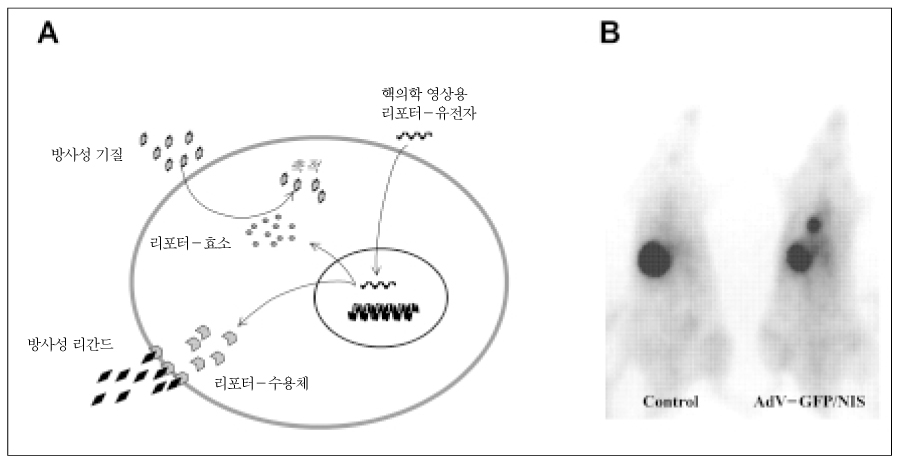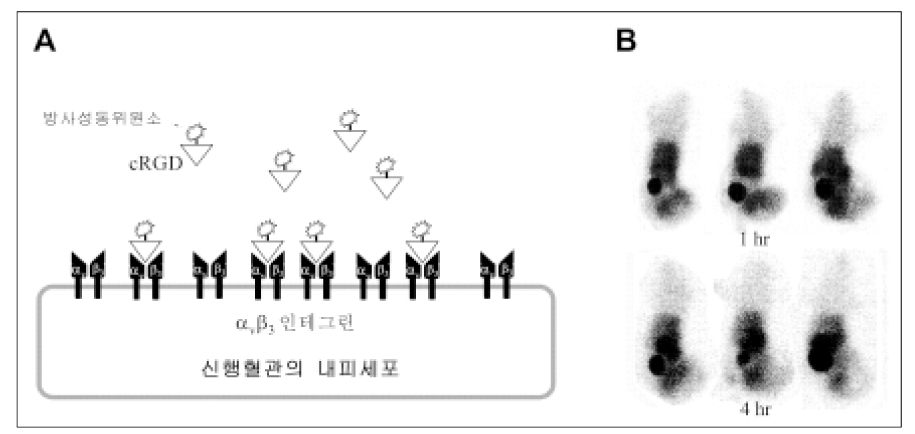 |
 |
- Search
| J Korean Med Assoc > Volume 47(2); 2004 > Article |
Abstract
Molecular imaging is emerging as an exciting new discipline that deals with imaging of disease on a cellular or genetic level. Nuclear medicine has traditionally focused on noninvasive imaging of in vivo physiology using radiolabeled tracers. As such, molecular imaging has its roots in nuclear medicine and in many ways is a direct extension of this field. The myriad of biological processes that may be targeted for molecular nuclear imaging can be grouped into direct and indirect strategies, depending on the type of imaging probe. The direct strategy uses de novo synthesis of molecular probes targeted to a specific molecular marker such as a receptor, transporter, or enzyme. For each novel target, new radiolabeled compounds are required as well as characterization of their detection sensitivity, interaction specificity, pharmacokinetics of delivery, and signal-to-noise ratio. The indirect strategy entails the use of a pretargeting molecule that is subsequently activated upon occurrence of a specific molecular event, which in turn is targeted by a specific molecular radioprobe. Reporter gene imaging falls into this category and provides a rapid and convenient tool to monitor gene expression by yielding a phenotype that is readily imaged upon expression. The remarkable efforts currently focused on the molecular nuclear technology signify its importance and wide range of application. With continued improvements in instrumentation, identification of novel targets, and design of better radioprobes, molecular nuclear imaging promises to play an increasingly important role in disease diagnosis and therapy.
References
1. Herschman HR. Molecular imaging:Looking at problems, seeing solutions. Science 2003;302:605-608.
2. Britz-Cunningham SH, Adelstein SJ. Molecular targeting with radionuclides: State of the science. J Nucl Med 2003;44:1945-1961.
3. Weissleder R, Mahmood U. Molecular imaging. Radiology 2001;219:3160-3333.
4. Nichol C, Kim EE. Molecular imaging and gene therapy. J Nucl Med 2001;42:1368-1374.
5. Gambhir SS, Barrio JR, Herschman HR, Phelps ME. Imaging gene expression: principles and assays. J Nucl Cardiol 1999;6(2):219-233.
6. Tjuvajev JG, Chen SH, Joshi A, Joshi R, Guo ZS, Blasberg RG, et al. Imaging adenoviral-mediated herpes virus thymidine kinase gene transfer and expression in vivo. Cancer Res 1999;59(20):5186-5193.
7. Gambhir SS, Barrio JR, Phelps ME, Iyer M, Namavari M, Herschman HR, et al. Imaging adenoviral-directed reporter gene expression in living animals with positron emission tomography. Proc Natl Acad Sci USA 1999;96(5):2333-2338.
8. Lee KH, Byun SS, Choi JH, Paik JY, Choe YS, Kim BT. Radioiodine labeled phenylethyl-D-thiogalactopyranoside as a radioprobe to monitor lacZ reporter gene expression. Eur J Nucl Med Mol Imaging 2004;In press.
9. MacLaren DC, Gambhir SS, Satyamurthy N, Barrio JR, Sharfstein S, Herschman HR, et al. Repetitive, non-invasive imaging of the dopamine D2 receptor as a reporter gene in living animals. Gene Ther 1999;6(5):785-791.
10. Umegaki H, Ishiwata K, Ogawa O, Ingram DK, Roth GS, Senda M, et al. In vivo assessment of adenoviral vector-mediated gene expression of dopamine D(2) receptors in the rat striatum by positron emission tomography. Synapse 2002;43(3):195-200.
11. Doubrovin M, Ponomarev V, Beresten T, Balatoni J, Bornmann W, Gelovani Tjuvajev J, et al. Imaging transcriptional regulation of p53-dependent genes with positron emission tomography in vivo. Proc Natl Acad Sci USA 2001;98(16):9300-9305.
12. Costouros NG, Diehn FE, Libutti SK. Molecular imaging of tumor angiogenesis. J Cell Biochem 2002;39:Suppl. 72-78.
13. Janssen ML, Oyen WJ, Dijkgraaf I, Massuger LF, Frielink C, Boerman OC, et al. Tumor targeting with radiolabeled αvβ3 integrin binding peptides in a nude mouse model. Cancer Res 2002;62:6146-6151.
14. Haubner R, Wester HJ, Weber WA, Mang C, Ziegler SI, Schwaiger M, et al. Noninvasive imaging of αvβ3 integrin expression using 18F-labeled RGD containing glycopeptide and positron emission tomography. Cancer Res 2001;61:1781-1785.
15. Lee KH, Song SH, Paik JY, Byun SS, Lee SY, Choe YS, Kim BT. Specific Endothelial binding and tumor uptake of radiolabeled angiostatin. Eur J Nucl Med Mol Imaging 2003;30:1032-1037.
16. Blankenberg F, Ohtsuki K, Wtrauss HW. Dying a thousand deaths: Radionuclide imaging of apoptosis. Q J Nucl Med 1999;43:170-176.
17. Blankenberg F, Katsikis PF, Tait JF. In vivo detection and imaging of phosphatidylserine expression during programmed cell death. Proc Natl Acad Sci USA 1998;95:6349-6344.
- TOOLS
-
METRICS

-
- 0 Crossref
- Scopus
- 1,100 View
- 3 Download
-
Related articles in
J Korean Med Assoc -
Alternative Medicine1997 September;40(9)







